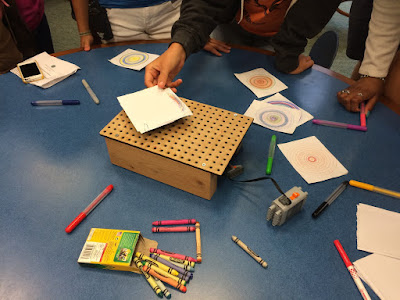As part of my Horizon's LEGO Grant Coordinator position I was invited to a couple of the sites for teacher professional development of skills with LEGO, tinkering, and learning through play.
For these sessions I defined tinkering as working with materials to learn how materials work.
For these sessions I defined tinkering as working with materials to learn how materials work.
I brought along three LEGO Tinkering machines that I constructed. Each was built around the Tinkering Studio's pegboard. Participants were encouraged to play with the machines, remix them, and to think about the simple technologies that combine to make complex projects.
The first machine was the perennial favorite, the spin art machine. It combined a motor, a platform, and recycled paper. Instead of paint, we used markers and crayons.
We noticed how different the ink or crayon looks while the machine spins versus how the completed art looks. The art informed us how to use the pens and crayons differently and the necessity, perhaps, or building a more robust platform so the artist can put more pressure on the paper as it spins.
The second machine I brought was an iteration of a sound machine. It uses a shaker on an arm that moves thanks to a cam. It also included a couple of the 3D printed LEGO Set Screw Pen Holders. I included some baby toys that made sounds and some upcycled containers.
With the machine hooked to the Power Functions battery pack, the motor turns quite fast.
The third machine was a storytelling machine. It used motion of the LEGO model, animation on the screen in the LEGO WeDo software, light, and shadows to tell a short story about a duck and a wolf. Part of the model is housed in a cardboard box so there is enough darkness for the light and shadows to work properly.
I really had fun with the simplicity and potential for creativity with this machine.
The participants had a good time using the machines. There were a few great remixes.
One group used watercolors with a spin art machine they constructed.
One participant used the spin art to create more art.
This piece was incorporated in a large dry erase board portrait that I neglected to photograph, unfortunately.
This group made great use of different materials with the sound machine to tinker with sound.
Overall, the sessions with three different Horizons sites were exceptionally fun! After warming up a little with the materials the participants truly played with the machines. They were free from the constraints of following directions. The sessions focused on learning different methods of connecting LEGO, utilizing LEGO with other materials, and using LEGO to create work that they would otherwise be incapable of producing. I look forward to the work the students are able to produce!










Comments
Thanks for this post - I'd love to try this with my 4th graders. I don't have the budget to buy full sets of the WeDo so was considering buying the replacement bag of Lego parts, the motor and the Smarthub. Do you think this project would work with only those parts? Thanks for any insights and advice as well as your time and inspiration!
Jill Jensen
K-5 Science specialist
Of course that would work! It's just once you piece together the parts, the hub, motor, and sensors a la carte, you've almost spent as much as the WeDo 1 kit. But the hub and motor, or even just the motor and the power supply, would work great! Have hard fun!